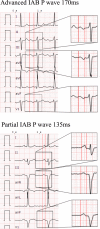Baseline ECG and Prognosis After Transcatheter Aortic Valve Implantation: The Role of Interatrial Block
- PMID: 33140688
- PMCID: PMC7763710
- DOI: 10.1161/JAHA.120.017624
Baseline ECG and Prognosis After Transcatheter Aortic Valve Implantation: The Role of Interatrial Block
Abstract
Background The clinical significance of conduction disturbances after transcatheter aortic valve implantation has been described; however, little is known about the influence of baseline ECGs in the prognosis of these patients. Our aim was to study the influence of baseline ECG parameters, including interatrial block (IAB), in the prognosis of patients treated with transcatheter aortic valve implantation. Methods and Results The BIT (Baseline Interatrial Block and Transcatheter Aortic Valve Implantation) registry included 2527 patients with aortic stenosis treated with transcatheter aortic valve implantation. A centralized analysis of baseline ECGs was performed. Patients were divided into 4 groups: normal P wave duration (<120 ms); partial IAB (P wave duration ≥120 ms, positive in the inferior leads); advanced IAB (P wave duration ≥120 ms, biphasic [+/-] morphology in the inferior leads); and nonsinus rhythm (atrial fibrillation/flutter and paced rhythm). The mean age of patients was 82.6±9.8 years and 1397 (55.3%) were women. A total of 960 patients (38.0%) had a normal P wave, 582 (23.0%) had partial IAB, 300 (11.9%) had advanced IAB, and 685 (27.1%) presented with nonsinus rhythm. Mean follow-up duration was 465±171 days. Advanced IAB was the only independent predictor of all-cause mortality (hazard ratio [HR], 1.48; 95% CI, 1.10-1.98 [P=0.010]) and of the composite end point (death/stroke/new atrial fibrillation) (HR, 1.51; 95% CI, 1.17-1.94 [P=0.001]). Conclusions Baseline ECG characteristics influence the prognosis of patients with aortic stenosis treated with transcatheter aortic valve implantation. Advanced IAB is present in about an eighth of patients and is associated with all-cause death and the composite end point of death, stroke, and new atrial fibrillation during follow-up.
Keywords: ECG; TAVI; TAVR; interatrial block; pacemaker; prognosis.
Conflict of interest statement
None.
Figures




References
-
- Zhang X, Wang T, Lan R, Dai Q, Kang L, Wang L, Wang Y, Xu W, Xu B. Meta‐analysis comparing results of transcatheter versus surgical aortic‐valve replacement in patients with severe aortic stenosis. Am J Cardiol. 2020;125:449–458. - PubMed
-
- Mack MJ, Leon MB, Thourani VH, Makkar R, Kodali SK, Russo M, Kapadia SR, Malaisrie SC, Cohen DJ, Pibarot P, et al. Transcatheter aortic‐valve replacement with a balloon‐expandable valve in low‐risk patients. N Engl J Med. 2019;380:1695–1705. - PubMed
-
- Bruna V, Velasquez‐Rodriguez J, Valero‐Masa MJ, Perez‐Guillem B, Vicent L, Diez‐Delhoyo F, Devesa C, Sousa‐Casasnovas I, Juarez M, Bayes de Luna A, et al. Prognostic of interatrial block after an acute ST‐segment elevation myocardial infarction. Cardiology. 2019;142:109–115. - PubMed
-
- Martin‐Demiguel I, Nunez‐Gil IJ, Perez‐Castellanos A, Vedia O, Uribarri A, Duran‐Cambra A, Martin‐Garcia A, Corbi‐Pascual M, Guillen Marzo M, Martinez‐Selles M. Prevalence and significance of interatrial block in Takotsubo syndrome (from the RETAKO Registry). Am J Cardiol. 2019;123:2039–2043. - PubMed
-
- Bayes de Luna A, Cladellas M, Oter R, Torner P, Guindo J, Marti V, Rivera I, Iturralde P. Interatrial conduction block and retrograde activation of the left atrium and paroxysmal supraventricular tachyarrhythmia. Eur Heart J. 1988;9:1112–1118. - PubMed

